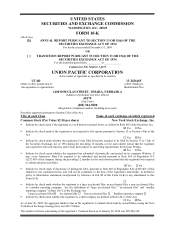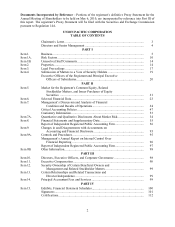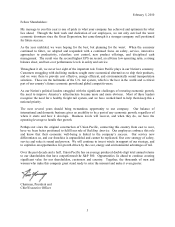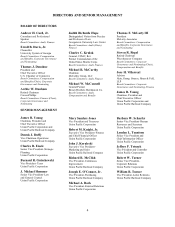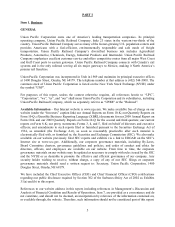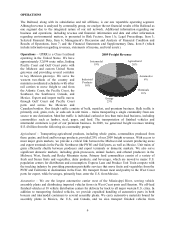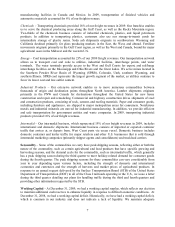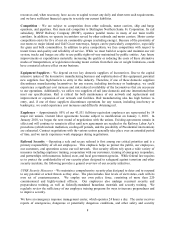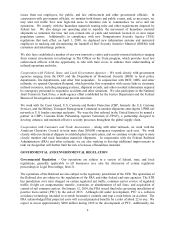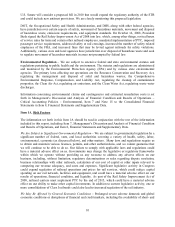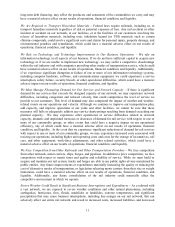Union Pacific 2009 Annual Report Download - page 11
Download and view the complete annual report
Please find page 11 of the 2009 Union Pacific annual report below. You can navigate through the pages in the report by either clicking on the pages listed below, or by using the keyword search tool below to find specific information within the annual report.11
long-term debt financing, may affect the producers and consumers of the commodities we carry and may
have a material adverse effect on our results of operations, financial condition, and liquidity.
We Are Required to Transport Hazardous Materials – Federal laws require railroads, including us, to
transport hazardous materials regardless of risk or potential exposure of loss. Any rail accident or other
incident or accident on our network, at our facilities, or at the facilities of our customers involving the
release of hazardous materials, including toxic inhalation hazard (or TIH) materials such as certain
chlorine compounds, could involve significant costs and claims for personal injury, property damage, and
environmental penalties and remediation, which could have a material adverse effect on our results of
operations, financial condition, and liquidity.
We Rely on Technology and Technology Improvements in Our Business Operations – We rely on
information technology in all aspects of our business. If we do not have sufficient capital to acquire new
technology or if we are unable to implement new technology, we may suffer a competitive disadvantage
within the rail industry and with companies providing other modes of transportation service, which could
have a material adverse effect on our results of operations, financial condition, and liquidity. Additionally,
if we experience significant disruption or failure of one or more of our information technology systems,
including computer hardware, software, and communications equipment, we could experience a service
interruption, safety failure, security breach, or other operational difficulties, which could have a material
adverse impact on our results of operations, financial condition, and liquidity.
We Must Manage Fluctuating Demand for Our Services and Network Capacity – If there is significant
demand for our services that exceeds the designed capacity of our network, we may experience network
difficulties, including congestion and reduced velocity, that could compromise the level of service we
provide to our customers. This level of demand may also compound the impact of weather and weather-
related events on our operations and velocity. Although we continue to improve our transportation plan,
add capacity, and improve operations at our yards and other facilities, we cannot be sure that these
measures will fully or adequately address any service shortcomings resulting from demand exceeding our
planned capacity. We may experience other operational or service difficulties related to network
capacity, dramatic and unplanned increases or decreases of demand for rail service with respect to one or
more of our commodity groups, or other events that could have a negative impact on our operational
efficiency, any of which could have a material adverse effect on our results of operations, financial
condition, and liquidity. In the event that we experience significant reductions of demand for rail services
with respect to one or more of our commodity groups, we may experience increased costs associated with
resizing our operations, including higher unit operating costs and costs for the storage of locomotives, rail
cars, and other equipment; work-force adjustments; and other related activities, which could have a
material adverse effect on our results of operations, financial condition, and liquidity.
We Face Competition from Other Railroads and Other Transportation Providers – We face competition
from other railroads, motor carriers, ships, barges, and pipelines. In addition to price competition, we face
competition with respect to transit times and quality and reliability of service. While we must build or
acquire and maintain our rail system, trucks and barges are able to use public rights-of-way maintained by
public entities. Any future improvements or expenditures materially increasing the quality or reducing the
cost of alternative modes of transportation, or legislation releasing motor carriers from their size or weight
limitations, could have a material adverse effect on our results of operations, financial condition, and
liquidity. Additionally, any future consolidation of the rail industry could materially affect the
competitive environment in which we operate.
Severe Weather Could Result in Significant Business Interruptions and Expenditures – As a railroad with
a vast network, we are exposed to severe weather conditions and other natural phenomena, including
earthquakes, hurricanes, fires, floods, mudslides or landslides, extreme temperatures, and significant
precipitation that may cause business interruptions, including line outages on our rail network, that can
adversely affect our entire rail network and result in increased costs, increased liabilities, and decreased

